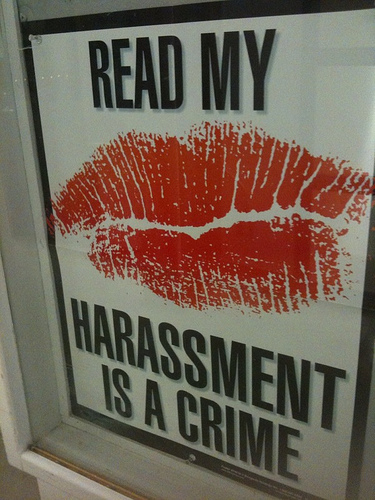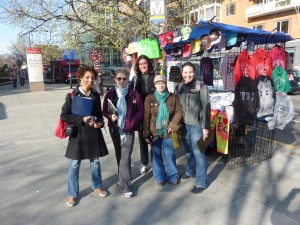 A very effective first step for creating community, city-wide, or campus-wide change around the issue of street harassment is to conduct a survey or a community safety auditto gather data that can allow you to make informed recommendations for changes.
A very effective first step for creating community, city-wide, or campus-wide change around the issue of street harassment is to conduct a survey or a community safety auditto gather data that can allow you to make informed recommendations for changes.
Ideally, you will do both a survey and an audit to have a range of data on issues of safety and harassment to use to make recommendations. For example, in 2011, Holla Back DC! conducted a survey of Washington, DC, residents, and with Stop Street Harassment, conducted two community safety audits with 16 teams.
Street harassment is an under-researched and under-studied topic and it’s difficult to create policy changes without statistics and data tracking its prevalence. Even informal data can make a difference.
Example #1:
Informal studies of hundreds of transit riders in Chicago (2009) and New York City(2007) showed that over 60 percent of women experienced sexual harassment but almost no one reported it. These studies led to public service awareness campaigns about sexual harassment on the subways to deter it and encourage people to report it, as well as more trainings of transit workers to handle the problem.
Example #2:
Through conducting a survey of their peers in the Rogers Park area (Chicago) the Young Women’s Action team was able to hone in on where street harassment was occurring and what was making girls feel unsafe. As a result, they took their survey data and successfully lobbied for more street lamps along two roads that were not well-lit and were able to get 120 businesses to participate in a “Respect” campaign to deter men from congregating outside the businesses and harassing girls and women walking by.
What to do:
1. Figure out the area you want to study.
Is it a campus? A high school? A whole city? A neighborhood? Transit riders?
2. Decide on the best method for surveying that audience
Does this mean creating a short questionnaire they can fill out on the spot as you canvass transit stops or houses? Will be a short questionnaire they can fill out in person when they walk past a table on a campus or in a high school? Should you create an online survey for them to fill out at their leisure? (SurveyMonkey lets you do a 10 question survey of 100 people for free and has reasonable rates if you want to have more questions and/or a larger survey pool).
3. Decide what questions you want to ask
It’s helpful to include some demographics questions. It’s also important to ask them where and what time of day or night they experience harassment. That way you can see if there are patterns. You may want to ask them who harasses them and if they’ve ever responded to the harasser or reported to it. How old were they when they first experienced harassment? If you have never conducted a survey before, consult with someone who has or research the best way to ask survey questions. Have a few different people test the survey before you use it so you can tweak questions they may not understand etc.
4. Decide how many people you want to survey and make a plan for how you can go about doing that.
You may need to recruit people to help distribute the survey if you are doing it offline.
5. Conduct the survey
6. Analyze your data
If you’ve never analyzed data before, you may want to get assistance from someone who has. Some recommendations may be clear from the survey results for what you can ask decision-makers to do to make the community safer with less harassment. If they aren’t, you may want to facilitate a discussion to share the results and brainstorm recommendations.
7. Take your results and recommendations to decision-makers
Depending on what area you surveyed, take your results to a high school principal, campus administrator, city council, neighborhood association, etc. You may also want to create a press release to share your results with the press.
 People have conducted Community Safety Audits since 1989, when the Metropolitan Action Committee on Violence against Women & Children (METRAC) developed it in Toronto. Since then, they’ve been conducted in cities across Canada and internationally in cities in Russia, the UK, India, South Africa, and Tanzania. The United Nations uses it in some of its work.
People have conducted Community Safety Audits since 1989, when the Metropolitan Action Committee on Violence against Women & Children (METRAC) developed it in Toronto. Since then, they’ve been conducted in cities across Canada and internationally in cities in Russia, the UK, India, South Africa, and Tanzania. The United Nations uses it in some of its work.
To conduct an audit, you gather a group of 5-7 people who come from a variety of backgrounds and who can offer unique perspectives from the others in the group about issues of safety and inclusion. The team will walk a few blocks across around two hours twice, once during the day and once at night after dark. They will have an audit form and will look for things like how many women versus men are in public, how are they using public spaces, and how well lit are the roads and parks. Each participant will also answer subjective questions like how safe they would feel if they were alone on the walk or how safe they’d feel waiting alone for a bus.
You can have several teams go out at once to cover different parts of a neighborhood, city, or campus, or the same team can conduct several audits.
Once you have the audit results, you can make recommendations for policy makers and other decision makers about how to make cities safer. For example, early audits conducted in Canada led to better lit parking lots.
What to Do:
Women in Cities International wrote a guide for how to conduct the audits and wrote a report on making gender inclusive cities.
